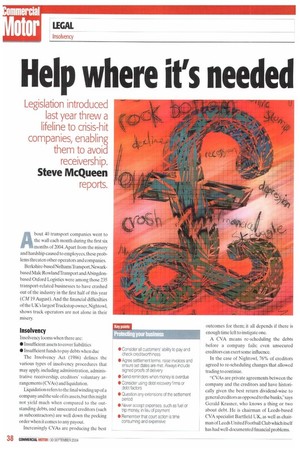elp where it's needed
Page 40

Page 41

If you've noticed an error in this article please click here to report it so we can fix it.
Legislation introduced last year threw a lifeline to crisis-hit companies, enabling them to avoid receivership.
Steve McQueen reports
About 40 transport companies went to the wall each month during the first six months of 2004. Apart from the misery and hardship caused to employees, these problems threaten other operators and companies.
Berkshire-based NelhamsTransport,Newarkbased Male RowlandTransport and Abingdonbased Oxford Logistics were among those 235 transport-related businesses to have crashed out of the industry in the first half of this year (CM 19 August). And the financial difficulties of the UK's largest Truckstop owner, Nightowl, shows truck operators are not alone in their misery.
Insolvency Insolvency looms when there are: • Insufficient assets to cover liabilities • Insufficient funds to pay debts when due The Insolvency Act (1986) defines the various types of insolvency procedures that may apply, including administration, administrative receivership, creditors voluntary arrangements (CVAs) and liquidation.
Liquidation refers to the final winding up of a company and the sale of its assets, hut this might not yield much when compared to the outstanding debts, and unsecured creditors (such as subcontractors) are well down the pecking order when it comes to any payout.
Increasingly CVAs are producing the best outcomes for them; it all depends if there is enough time left to instigate one.
A CVA means re-scheduling the debts before a company fails; even unsecured creditors can exert some influence.
In the case of Nightowl, 76% of creditors agreed to re-scheduling changes that allowed trading to continue.
"CVAs are private agreements between the company and the creditors and have historically given the best return dividend-wise to general creditors as opposed to the banks," says Gerald Krasner, who knows a thing or two about debt. He is chairman of Leeds-based CVA specialist Bonfield UK, as well as chairman of Leeds United Football Club which itself has had well-documented financial problems. -As far as the company's situation is concerned, it has to happen at about 9pm instead of at five minutes to midnight and there also has to he a viable business left after any surgery that might be necessary."
There are now some 400-500 CVAs a year, producing returns of 40-60% on outstanding debts. Krasner adds that they are also a more cost-effective solution. "CVAs usually last about three years and will accrue administrative and legal costs of around £30,000 per company." he adds. "A company in receivership will cost that amount in about six weeks."
Steven Law is a partner at the insolvency firm Ensor and is a council member at R3, the brand name for the society of insolvency practitioners. He reports that CVAs are an increasingly favoured option, arising from a close approximation to the US Chapter 11 protection laws introduced last year in the UK under the Enterprise Act 2002.
Amendments to the terms of administration mean that any company can now obtain immediate protection from its creditors by filing modest paperwork with a court, having obtained the consent of its bank.
It won't simply clear the decks of any debt, however. -The administrator's primary objective will be to rescue the company as a going concern, which is likely to involve the restructuring of debts," says Law. "Alternatively, the adminstrator will seek to sell the business or parts of it to achieve a better result than a liquidation."
Best chance Administrators (usually called in by company directors) or administrative receivers (usually appointed by debenture holders such as the banks) take the same line and sometimes sell to the incumbent management if it is felt this represents the best chance of hanging on to existing contracts.
Creditors often find this resolution distasteful because it rarely includes responsibility for the associated debt — and there is no way the outstanding amount can be pursued.
But if you are a subcontractor with goods in storage or transit at the time of the crash your position is stronger: Your 'rights' can be enhanced if you are carrying a consignment when you learn of the customer's insolvency," Law explains. -In that instance you could claim a lien on the goods in transit and negotiate payment of old debts before you complete delivery of the consignment.
"Once the goods are delivered your position is weakened. Therefore you will need to take immediate action to establish what goods are held. In the event that the insolvency practitioner continues to trade the insolvent business and wants to use your services, you will probably be asked to sign an undertaking to confirm that you will not apply a lien to new goods handled."
Creditors' meeting are usually held within three months of an insolvency being declared. R3 says it's worth being represented and advises creditors to volunteer to join any creditors' committee.
This provides direct access to information from the insolvency practitioner and represents the best line of communication. Specialist industry knowledge can also be used to ensure that good money is not spent chasing bad.
So, whether it's your own company or a client that's in trouble, early action means damage limitation and early advice from a recovery specialist might lead to a company's rebirth rather than its last rites. •


































































































































































































